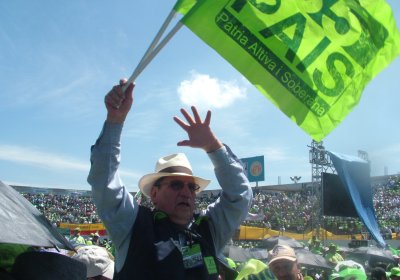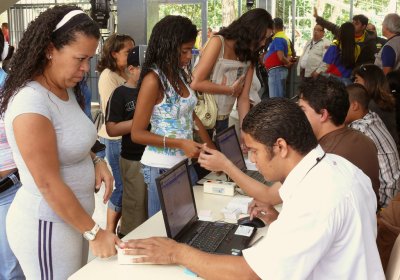The Venezuelan government has responded to opposition and private media accusations that it is being “mysterious” regarding information on Chavez’s health situation, and has called such statements as well as rumours being spread on social networks “psychological warfare”.
Tamara Pearson
President Hugo Chavez announced on public television on the night of December 8 that he would return to Cuba to receive surgery for new malignant cells, and that vice-president Nicolas Maduro will be in charge during his absence.
Chavez said Cuban doctors informed him that the area where he has previously been affected will need to be operated on again, as new malignant cells have appeared.
He also said that “there are always risks in processes like this” and that “if anything happens to me that hinders me [from performing as president]”, Maduro was his preference to replace him.
About 25,000 people squished themselves into the sports stadium of Chillogallo, the most populated area of Quito, to launch the candidates of President Rafael Correa’s Alianza PAIS (Country Alliance, or AP) on November 10. Elections are scheduled for next February for the presidency and National Assembly.
The Venezuelan government will begin a process of recovering 300,000 hectares of land during April that have been in the hands of an unnamed English company, Venezuelan President Hugo Chavez said in an interview during his trip to Uruguay.
Chavez said the process of taking back or “recovering” land had been fundamental to the revolutionary process led by his government. He said this especially so that “worker control” could “prevent companies from exploiting the land and workers, and getting rich and taking the earnings overseas”.
Venezuela marked the 12th anniversary of President Hugo Chavez’s first oath of office in February 1999 on February 2.
Chavez won presidential elections in December 1998 on a pro-poor program that pledged to break the corrupt, two-party system that had dominated Venezuela since 1958.
To commemorate the occasion, Chavez and supporters held four televised site visits in Caracas. The visits highlighted gains in education, food, health and people’s power that have occurred as part of the “Bolivarian revolution” the Chavez government is leading.
Venezuelan President Hugo Chavez expressed his support for workers in a dispute at a Venezuelan Coca-Cola plant conflict in a televised address on February 4.
“If Coca-Cola doesn’t want to comply with the constitution and the law, well, we can live without Coca-Cola,” he said to cheers from the crowd.
Chavez was speaking in Valencia, the capital of Carabobo state, where 1230 workers are striking in a bottling and distribution plant of Coca-Cola Femsa.
More than 1000 members of the United Socialist Party of Venezuela (PSUV) met with President Hugo Chavez on January 19 and decided on five key strategic lines for the next two years.
The discussion included recognition of important weaknesses in the party.
Chavez, who is also president of the governing PSUV, presented the document, Strategic Lines of Political Action of the PSUV for 2011-2012, to the “National Assembly of Socialists” in Vargas state.
About 1440 party leaders were present.
Mérida, September 30th 2010 (Venezuelanalysis.com) – As a coup attempt takes place in Ecuador, Venezuela and regional organisations of Latin America have come out in solidarity with Ecuador, and Venezuelan President Hugo Chavez called on the people and military of Ecuador to defend President Rafael Correa and their country’s democracy.
Ecuador is a close ally of Venezuela, and a fellow member of the progressive Bolivarian Alliance of the People of Our America (ALBA).
Francisco Chavez Abarca, who was recently extradited to Cuba, has admitted being contracted by Cuban-born terrorist Luis Posada Carriles to carry out destabilising acts in Venezuela in the lead-up to the September National Assembly elections.
Posada Carriles is a former CIA agent wanted for his role in a 1976 attack on a Cuban plane that left 73 passengers dead. He lives in Miami. The US government, going against international law, has refused Venezuelan and Cuban requests to extradite him.
Leaders from Latin America and the Caribbean approved on February 23 a regional organisation that will unite their countries, but that will not involve either the United States or Canada.
Venezuelan President Hugo Chavez has inaugurated new government-run hypermarkets (large supermarkets), which replace of the recently nationalised Exito hypermarket chain.
Officials from the Venezuelan National Land Institute, supported by the National Guard, took over 31 farms across the country on November 23, totalling 19,000 hectares of farmland. The government said the landowners did not have legal titles or were not putting the land to adequate use.
- Previous page
- Page 6
- Next page





